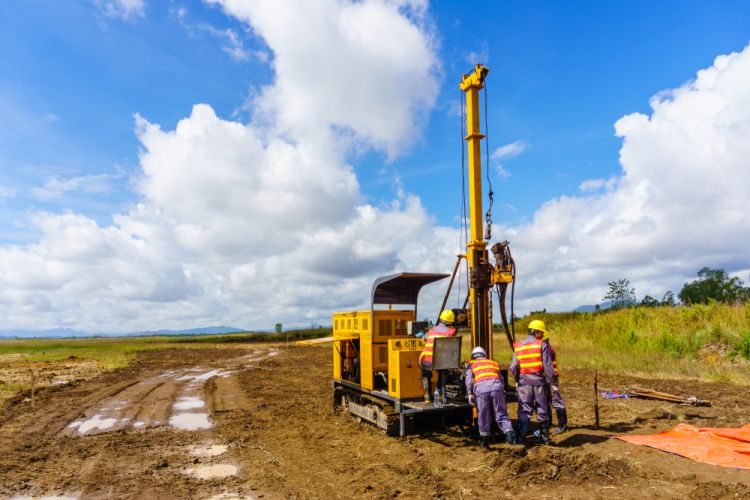Getting My Specialized Geotechnical Engineering Solutions To Work
Getting My Specialized Geotechnical Engineering Solutions To Work
Blog Article
Everything about Specialized Geotechnical Engineering Solutions
Table of ContentsIndicators on Specialized Geotechnical Engineering Solutions You Should KnowThe Ultimate Guide To Specialized Geotechnical Engineering SolutionsSpecialized Geotechnical Engineering Solutions Fundamentals ExplainedSpecialized Geotechnical Engineering Solutions for Dummies8 Simple Techniques For Specialized Geotechnical Engineering SolutionsThe 9-Minute Rule for Specialized Geotechnical Engineering Solutions
William Rankine, a designer and physicist, established a different to Coulomb's earth stress theory. Albert Atterberg developed the clay uniformity indices that are still utilized today for dirt classification. In 1885, Osborne Reynolds acknowledged that shearing causes volumetric dilation of thick products and tightening of loosened granular materials. Modern geotechnical engineering is stated to have begun in 1925 with the publication of Erdbaumechanik by Karl von Terzaghi, a mechanical designer and rock hound. Terzaghi additionally created the framework for concepts of bearing capacity of foundations, and the theory for forecast of the rate of negotiation of clay layers as a result of combination. Afterwards, Maurice Biot completely established the three-dimensional dirt consolidation theory, extending the one-dimensional model formerly created by Terzaghi to extra general hypotheses and presenting the set of standard equations of Poroelasticity.
Geotechnical designers investigate and establish the homes of subsurface conditions and products.
Facts About Specialized Geotechnical Engineering Solutions Uncovered
Geologic mapping and analysis of geomorphology are commonly completed in appointment with a rock hound or design rock hound. Subsurface exploration usually entails in-situ screening (for instance, the common penetration examination and cone infiltration examination). The excavating of test pits and trenching (especially for finding faults and slide aircrafts) might also be used to learn more about dirt conditions at deepness. , which makes use of a thick-walled split spoon sampler, is the most typical way to accumulate disrupted samples.

Normally, the user interface's specific geometry is unknown, and a streamlined user interface geometry is thought. Finite slopes call for three-dimensional designs to be examined, so most slopes are examined assuming that they are considerably vast and can be stood for by two-dimensional designs.
Unknown Facts About Specialized Geotechnical Engineering Solutions

Dimension of amounts and assessment of real problems. Design adjustment per actual conditions The empirical technique is ideal for building that has actually currently begun when an unexpected advancement happens or when a failing or crash looms or has actually currently occurred. It disagrees for tasks whose layout can not be modified throughout building and construction.
Principles of Geotechnical Engineering. Dirt Mechanics and Foundations. Disturbed soil residential properties and geotechnical layout, Schofield, Andrew N., Thomas Telford, 2006.
Little Known Questions About Specialized Geotechnical Engineering Solutions.
Principles and Method of Ground Improvement. Ground Improvement Principles And Applications In Asia. Layout analysis in rock auto mechanics.
Cengage Discovering, Stamford, 666 p. Atkinson, J., 2007. The mechanics of dirts and structures. Taylor & Francis, N.Y., 442 p. Drifting Offshore Wind Generators: Feedbacks in a Sea state Pareto Ideal Styles and Financial Evaluation, P. Sclavounos et al., October 2007. Nicholson, D, Tse, C and Dime, C. (1999 ). The Observational Technique in ground design concepts and applications.
Little Known Questions About Specialized Geotechnical Engineering Solutions.
These records are tailored to meet the specific needs of a job and include design specifications and suggestions for the construction of a series of man-made structures. As offering working as a consultant services covering areas such as slope stability and load-bearing capacities for various products, these engineers carry out study and development activities to boost approaches, devices, products knowledge and evaluation covering whole lifecycles.
Design the residential properties and auto mechanics of rocks including the application of characteristics, my link fluid technicians, kinematics and material auto mechanics. This combines geology, dirt and rock auto mechanics, and architectural engineering for the design and building and construction of structures for a series of civil design tasks. This field involves anticipating the efficiency of structure dirt and rock to a Homepage tons imposed by a structure, while taking into consideration efficiency, economic situation and safety.
Nonetheless, prices of pay typically raise as your expertise and skills grow, with standards indicating a graduate beginning income of in between 18,000 and 28,000 annually in the UK. This rises to 26,000 to 36,000 with a couple of click this years of experience and afterwards reaching 40,000 to 60,000+ for elderly, legal or master designers.
The Basic Principles Of Specialized Geotechnical Engineering Solutions
However, with the ideal application it is possible to master the occupation and gain entrance to a tough yet fulfilling and crucial profession. A geologist would need to retrain to end up being a geotechnical designer, although there is a lot of cross-over between both careers, which can make this much easier. Geologists need to have an understanding of dirts, rocks and various other materials from a scientific perspective, while geotechnical engineers story their understanding of issues such as soil and rock technician, geophysics and hydrology and use them to engineering and ecological projects.
When beginning, these engineers will often tend to work with much less complicated projects, developing up knowledge and experience ready for even more tough work later. Geotechnical designers have a tendency to specialise in particular areas as they expand in experience, concentrating on specific frameworks such as railways, roads or water. These engineers also collaborate with renewable resource, offshore and onshore oil and gas, nuclear power, and extra.
Report this page